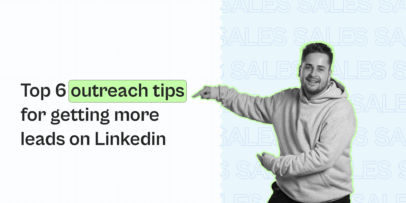The 3 Best Methods for B2B Prospecting – Expandi
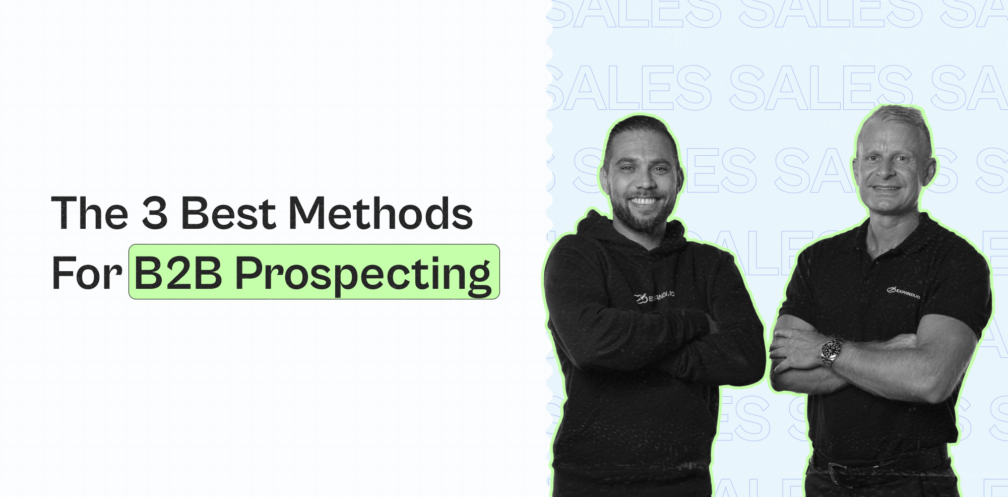
If you’re doing online research on the best B2B prospecting and lead generation methods, you’ll find in many places that referrals are the largest source of sales and marketing leads for many companies.
Referrals are a great way to grow your business when people in your industry make an effort to refer or suggest your product or service.
And to highlight how vital referral marketing is in the B2B world, here are a few numbers you should keep in mind, according to ThinkImpact:
- Referrals end up creating 65% of new business opportunities.
- 78% of referrals make viable customer leads for B2B businesses.
- Just 3 in every 10 B2B businesses have a formalized referral business.
Yes, referrals are essential, but the one downside is that it’s hard to prioritize referrals as a consistent source of B2B prospecting strategy.
Especially if you don’t have a large audience in the first place.
In that case, you’ll most likely want to focus on other B2B prospecting methods.
Methods that focus on outreach and finding your target audience in their natural channels.
This is what we’ll be focusing on in this guide.
Once you finish reading this article, you’ll have a better idea of where to find your B2B business leads and how to get in touch with them – all automatically.
Here’s what we’ll cover:
- What Is B2B Sales Prospecting: Overview and Outreach Campaign Metrics
- 3 B2B Prospecting Methods That Don’t Work
- 3 B2B Prospecting Methods That Work

What Is B2B Sales Prospecting: Overview and Outreach Campaign Metrics
So, where do we begin?
B2B sales prospecting is the act of looking for potential buyers, leads, or clients and converting them into new business for you.
The end goal of prospecting is to nurture your prospects through an outreach sequence until they convert or make a purchase.
Now, this may sound easier said than done.
According to HubSpot, 50% of sales time is wasted on unproductive prospecting.
This might be because of some reasons, such as:
- Using prospecting methods that aren’t suitable for B2B marketing (which we’ll cover below).
- Targeting the wrong audience (might be the case if you don’t know how to filter LinkedIn searches properly).
- Not structuring your cold messages or not putting your best value proposition forward when interacting with leads.
The point is, it’s hard to say what works and what doesn’t without following data.
You can make certain assumptions based on your industry and know your target audience. For example, knowing that you’re more likely to capture your leads’ attention through emails instead of a Facebook or Twitter message.
Before we cover the practical B2B prospecting strategies, here are some other concepts you should keep in mind when building your sales pipeline.
5 Different sales prospecting stages to keep in mind
When doing outreach or prospecting of any kind, you’ll want to segment and organize your leads based on their stage in their buyer’s journey.
Your sales pipeline and prospecting stages may differ depending on your CRM and what your leads prioritize before making a purchase.
But as a generalization, your B2B sales pipeline might look something like this:
- Discovering and qualifying – Contact your leads to decide if your solution fits their needs.
- Meeting – The first real discovery call is when you meet with the prospect to understand them better.
- Proposal – If your product or solution aligns with what they need, you’ll want to send them a proposal describing your benefits, the investment cost, expected ROI, and more.
- Negotiation – Depending on your proposal, your prospect will accept or try to negotiate certain aspects (e.g., budget).
- Closing – Finally, everything checks out and you close the deal with your prospect. You’ll want to update your CRM accordingly and focus on client retention.
Keep in mind not everyone will be ready to buy from you straight away and the prospecting method you choose should have a clear solution depending on the kind of lead you’re working with.
For example, if someone isn’t ready to make a buying decision yet because they’re focusing on hiring, you can set an automated LinkedIn follow-up message to check in with them in 2-3 months.
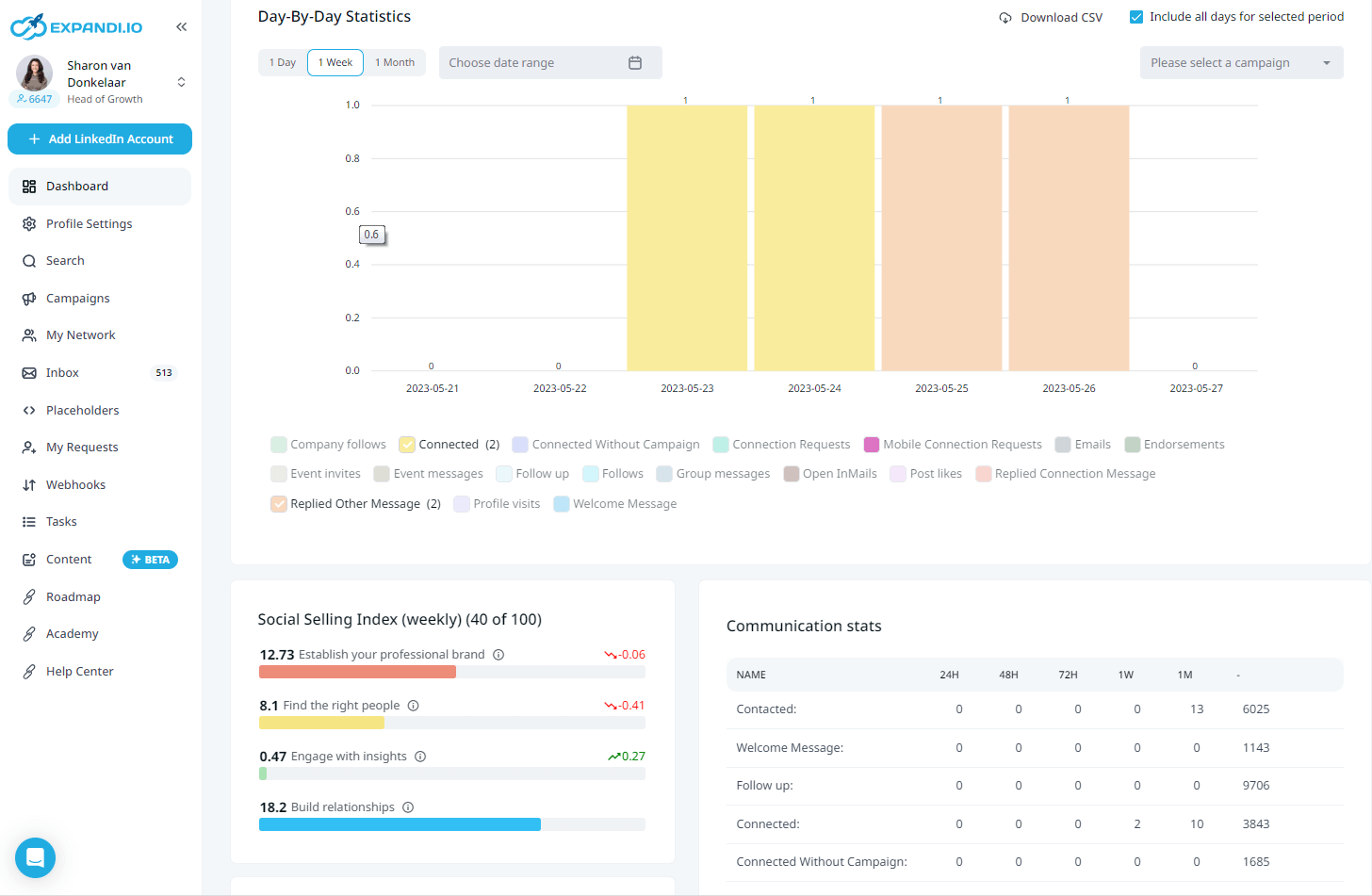
Alternatively, if they don’t know much about your product or service yet and need more convincing, you can keep their contact info and invite them to your webinar or send some educational content.
B2B Prospecting metrics and how to track them
If you want your B2B prospecting to succeed, you should be tracking the critical effectiveness of your sales pipeline and what’s working and what’s not.
Some metrics might include:
- Number of qualified leads
- MQL to SQL conversion rate – How many of your marketing-qualified leads to becoming sales qualified leads.
- Win rate – Number of qualified leads that then become clients.
- Customer acquisition cost – How much it costs you in sales and marketing expenses to get a new client.
- Customer lifetime value – How valuable your customers are throughout your business relationship (e.g., how long they work with you on average and how much they spend on your product or services).
- Outreach sales metrics – Email open rates, LinkedIn connection request acceptance, reply rate, follow-ups, links clicked, etc.
Now, some of these can be tracked automatically, depending on your prospecting tools, and others you’ll probably be monitoring internally in your CRM or custom Google Sheets document.
For example, with Expandi, you can see all of your campaign performance (email, LinkedIn stats) at a glance from the easy-to-understand dashboard.
Wondering what all these numbers mean?
Here’s a quick overview.
Understanding campaign metrics and KPIs
One important thing to keep in mind when measuring your prospecting metrics and KPIs is that they vary and depend on many things.
Such as your industry, your outreach campaign templates, your target audience, your offer, and so on.
But assuming you’re running B2B prospecting outreach campaigns (which we’ll also explore below again), here are some standard outreach benchmarks you should be aiming for, according to Woodpecker:
- Average open rate – 49%-70%.
- Average open rate – 9%-18%.
- Average booking rate – 4%.
This will also vary and fluctuate depending on the number of prospects you’re reaching out to, so keep that in mind.
If you feel you’re not hitting those benchmark numbers with your outreach campaigns, you can:
- If you have a low open rate, change your subject line. Check out our subject line templates for inspiration.
- If you have a low reply rate, change your sales pitch angle, change your value proposition, or change your call-to-action.
- If you have a low meeting booking rate, consider changing your offer or the audience you’re reaching out to. You should be selling something similar to what your audience is already buying.
Now, let’s get practical and finally cover some B2B prospecting methods that work and methods that don’t.
We’ll start with the latter first and also provide solutions or alternatives.
Starting with…
3 B2B Prospecting Methods That Don’t Work
Before we explore this, it’s essential to keep in mind that the only time you should be disqualifying prospecting methods completely is by following data.
You should always be keeping track of what works and what doesn’t.
And even then, you should always be A/B testing your prospecting methods.
This leads us to our first B2B mistake.
1. Not A/B testing your prospecting messages
Consider the following scenario:
You warm up your email domain and launch your first outreach campaign – only to get below-average industry benchmarks. You then shrug it off and proceed to the following prospecting method.
Which would be a huge mistake.
In general, email and LinkedIn have proven B2B prospecting channels (see below), but crossing them out due to poor first campaign results would be a huge mistake.
As mentioned above, your prospecting results will vary based on who you’re targeting, the cold messages you write, and many other factors.
So, the point here is, even if you’re experimenting with a different marketing channel, you should always A/B test your outreach messages and prospecting format to see what works best.
The best way to do this is to change only one thing at a time. A few ideas could be:
- Two LinkedIn connector campaigns with different request messages.
- Two various email subject line campaigns to see which one would get a higher open rate.
- One campaign using the Expandi X Hyperise integration and one without.
Even when focusing on one specific prospecting channel (e.g., LinkedIn), it’s worth A/B testing your messages to see what works best, based on data.
Fortunately, with Expandi, it’s very simple to A/B test your LinkedIn outreach campaigns.
You have to assign search results to the type of campaign you want to A/B test. After adding selected contacts to your campaign, each user will be added to the campaigns chosen randomly.
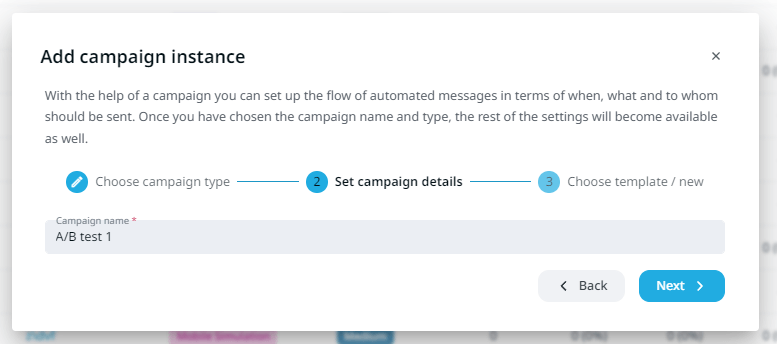
2. “Shotgun blast” outreach marketing
Unfortunately, this is a standard outreach method you see in LinkedIn and email.
The idea is that you don’t have to take so much time for “aiming” (personalizing) and simply do an automated, mass outreach to your target audience.
It might have worked at some point with email outreach for gathering SEO backlinks, but nowadays, it’s not even worth A/B testing this.
Especially on LinkedIn.
People are sick and tired of spammy connection requests with little to no personalization.
It doesn’t stand out and most people already know an automated sales pitch will follow as soon as they accept a request.

The solution?
It sounds time-consuming, but putting in the time for personalization will always pay off, compared to this outdated method.
But if you don’t have the time to do it yourself or the budget to outsource it, you can use an AI-personalization tool like Lyne to write your intro lines for you!

This is what we did in our LinkedIn InMail outreach campaign and landed 14+ calls in one week.
Check it out to learn how Lyne works and how to set up a similar campaign for your company in under a day!
3. Not automating your prospecting
Now, we mentioned above how automating done wrong can ruin your campaigns.
If you are automating your sales prospecting, you should take the time to set it up right.
That means:
- No jumping into an automated sales pitch.
- No spammy outreach with no personalization.
- Not optimizing your LinkedIn account.
Brushing off sales automation altogether would be a huge mistake. Done well, here’s what fully-optimized sales prospecting can look like when doing B2B outreach:
- Automatically like a prospect’s post from the last ten days.
- Send a personalized connection request.
- Send a hyper-personalized email with a GIF to remind them about your LinkedIn connection request.
- Ask a qualifying or engaging question once they accept.
- Manually step in and write a personalized reply based on their reply.
As you can see, this takes a lot of manual work out of the equation, and you can still pause the campaign at any point to step in and intervene yourself.
Alternatively, you can only automate the LinkedIn part or the email part.
Now, let’s look at some proven B2B prospecting methods.
3 B2B Prospecting Methods That Work
It’s becoming increasingly challenging to generate leads with “classic” B2B prospecting methods.
And to make things worse, the new LinkedIn limit stops people from sending more than 100 connection invites per week.
Fortunately, there are some other prospecting and lead generation strategies you can try, such as:
1. Launching your own LinkedIn webinar
LinkedIn events are a great way to position yourself as an authority figure and grow your network.
But the elephant in the room:
How do you grow your first webinar if you don’t have a lot of connections?
The first webinar we hosted got only 12 attendees, which was around 6-12 months ago.
Since then, though, we’ve started utilizing some untapped promotion strategies to get 1,000+ attendees for your first webinar event. Strategies that can be easily replicated.
Here’s the short version of what that looks like:
- Organic posting through speakers’ optimized profiles (videos, shorts, polls, announcements, etc.).
- Going viral with LinkedIn engagement pods.
- Scraping your polls and reaching out to those who answered.
- Automatically inviting your LinkedIn network throughout the month.
- Scraping other LinkedIn events in your industry for targeted outreach.
- Scraping LinkedIn groups related to your event topic.
- Connecting with people through a CSV connector campaign to bypass the 100 connections per week limit.
- Open InMail outreach campaign to boost your reach further even more.
These are just a few of the many prospecting methods we covered in our LinkedIn events promotion strategies guide. Check that out to also learn how to prepare for your webinar and what you should be doing before, during, and after your big event to get up to 1,000+ attendees.
2. Full funnel marketing automation
We mentioned this briefly above, but marketing funnel automation is surprisingly effective if you don’t know just how many prospecting tactics can be put on autopilot.
The main one, of course, is omnichannel outreach, which you can easily set up with Expandi’s drag-and-drop flows.
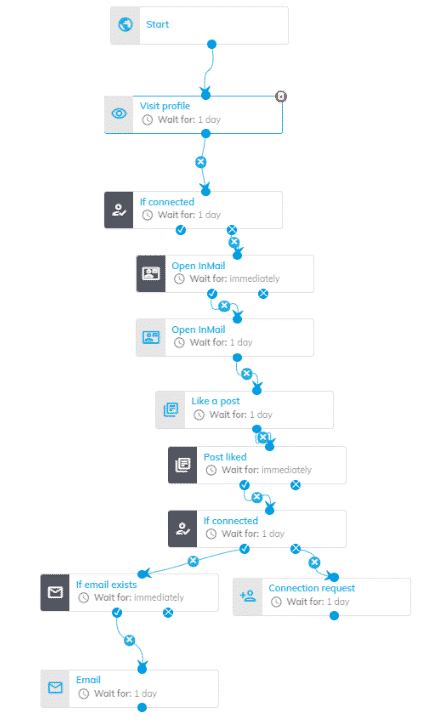
And the best part is you can create your custom flows based on your actions and conditions.
Or use the many free funnel automation templates that come with Expandi.
3. Hyper-personalized dynamic GIFs and images in your outreach
So, here’s how this works:
Similar to how you can personalize your email cold messages with tags like {first_name}, {company_name}, and so on. You can just as easily personalize dynamic images (or GIFs) with your prospect’s name, profile picture, company logo, landing page, and more.
This is done through a Hyperise integration and it’s easier than you might think.

Here’s what makes this B2B prospecting method so effective:
- The average person sees up to 5,000 marketing messages per day.
- User engagement with content has gone down by 60% and information overload makes consumers tune out.
- Your message only has 8 seconds to capture and hold attention.
Meanwhile, a pattern interrupts with your prospect’s name is much more effective when it comes to standing out.
Humans are hardwired to process images and visuals in milliseconds. And this type of prospecting also humanizes your outreach, especially if you’re using a custom GIF of yourself.
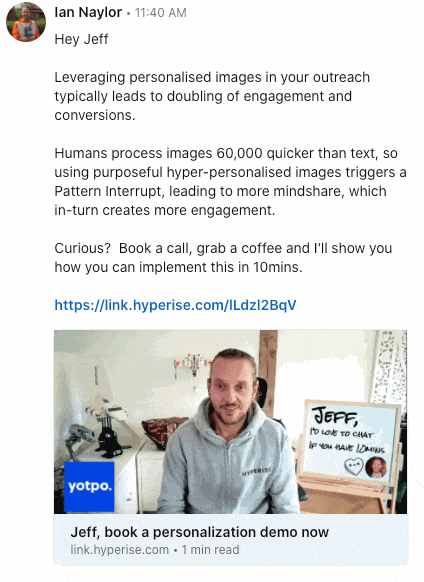
Then, you can combine this with method #2, as you can also utilize hyper-personalized GIFs in your LinkedIn messages.
The platform will simply see it as an attached file and it will show up the same way you see above.
Though keep in mind you can’t send dynamic GIFs like these in your LinkedIn connection request.
Conclusion
Now, let’s sum up.
- What is B2B prospecting?
In simple words, B2B prospecting is the process of looking for buyers, customers, or leads to turn them into clients. The end goal of most B2B prospecting methods is to reach out to your leads and nurture them through your sales funnel until they make a purchase and convert.
- Where can I find prospects for B2B?
This will largely depend on your target audience, but for the most part, the best place to find quality B2B prospects is on LinkedIn. However, this is not the only place, as you can also look for relevant prospects through Capterra, G2, Angel List, Crunchbase, and more.
- What is prospecting in business?
Prospecting is essentially finding potential clients and qualifying them in your outreach. The process consists of two main parts: outreach (sending a cold message, usually on LinkedIn, email, etc.) and nurturing (qualifying questions, how you can help, so on.).
- How do you attract a B2B customer?
There are two main ways to attract a B2B customer: inbound or outbound marketing. Inbound simply means creating and distributing content (e.g., LinkedIn webinar) and having them come to you. While outbound means proactively reaching out to them to get them interested in your offer.
Ready to launch your own omnichannel B2B prospecting campaign on LinkedIn as well as email?
Get started with a live demo or a free, 7-day Expandi trial to improve your sales and marketing performance now!
You’ve made it all the way down here, take the final step

